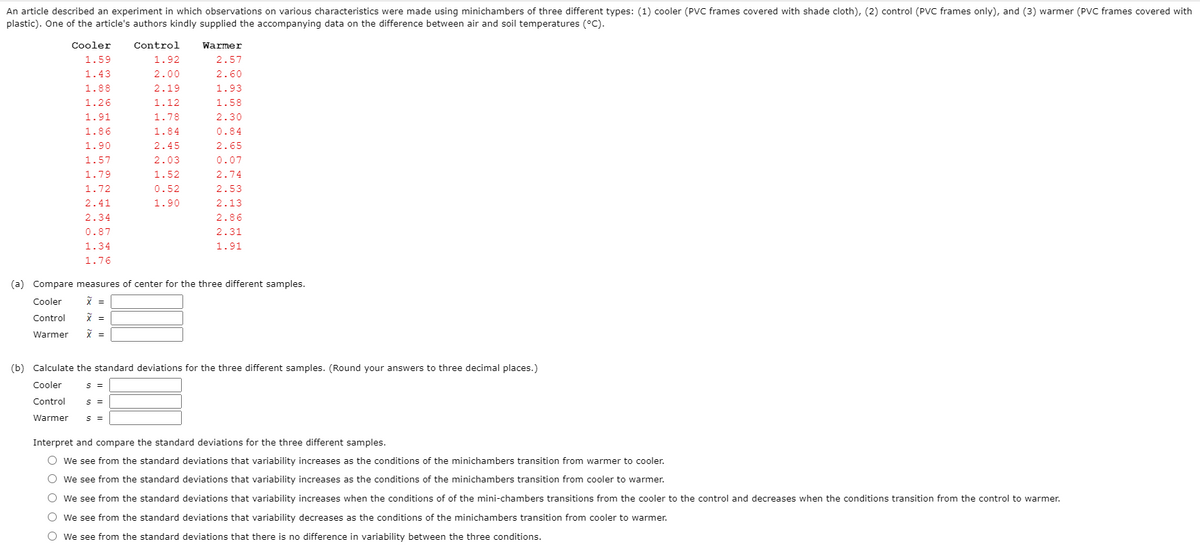An article described an experiment in which observations on various characteristics were made using minichambers of three different types: (1) cooler (PVC frames covered with shade cloth), (2) control (PVC frames only), and (3) warmer (PVC frames covered wit plastic). One of the article's authors kindly supplied the accompanying data on the difference between air and soil temperatures (°C). Control 1.92 Cooler Warmer 1.59 2.57 1.43 2.00 2.60 1.88 2.19 1.93 1.26 1.12 1.58 1.91 1.78 2.30 1.86 1.84 0.84 1.90 2.45 2.65 1.57 2.03 0.07 1.79 1.52 2.74 1.72 0.52 2.53 2.41 1.90 2.13 2.34 2.86 0.87 2.31 1.34 1.91 1.76 (a) Compare measures of center for the three different samples. Cooler Control Warmer
An article described an experiment in which observations on various characteristics were made using minichambers of three different types: (1) cooler (PVC frames covered with shade cloth), (2) control (PVC frames only), and (3) warmer (PVC frames covered wit plastic). One of the article's authors kindly supplied the accompanying data on the difference between air and soil temperatures (°C). Control 1.92 Cooler Warmer 1.59 2.57 1.43 2.00 2.60 1.88 2.19 1.93 1.26 1.12 1.58 1.91 1.78 2.30 1.86 1.84 0.84 1.90 2.45 2.65 1.57 2.03 0.07 1.79 1.52 2.74 1.72 0.52 2.53 2.41 1.90 2.13 2.34 2.86 0.87 2.31 1.34 1.91 1.76 (a) Compare measures of center for the three different samples. Cooler Control Warmer
A First Course in Probability (10th Edition)
10th Edition
ISBN:9780134753119
Author:Sheldon Ross
Publisher:Sheldon Ross
Chapter1: Combinatorial Analysis
Section: Chapter Questions
Problem 1.1P: a. How many different 7-place license plates are possible if the first 2 places are for letters and...
Related questions
Question
Please solve the (a) only in the screenshot and show all work!

Transcribed Image Text:An article described an experiment in which observations on various characteristics were made using minichambers of three different types: (1) cooler (PvC frames covered with shade cloth), (2) control (PVC frames only), and (3) warmer (PVC frames covered with
plastic). One of the article's authors kindly supplied the accompanying data on the difference between air and soil temperatures (°C).
Cooler
Control
Warmer
1.59
1.92
2.57
1.43
2.00
2.60
1.88
2.19
1.93
1.26
1.12
1.58
1.91
1.78
2.30
1.86
1.84
0.84
1.90
2.45
2.65
1.57
2.03
0.07
1.79
1.52
2.74
1.72
0.52
2.53
2.41
1.90
2.13
2.34
2.86
0.87
2.31
1.34
1.91
1.76
(a) Compare measures of center for the three different samples.
Cooler
X =
Control
Warmer
X =
(b) Calculate the standard deviations for the three different samples. (Round your answers to three decimal places.)
Cooler
S =
Control
S =
Warmer
S =
Interpret and compare the standard deviations for the three different samples.
O we see from the standard deviations that variability increases as the conditions of the minichambers transition from warmer to cooler.
O we see from the standard deviations that variability increases as the conditions of the minichambers transition from cooler to warmer.
O we see from the standard deviations that variability increases when the conditions of of the mini-chambers transitions from the cooler to the control and decreases when the conditions transition from the control to warmer.
O we see from the standard deviations that variability decreases as the conditions of the minichambers transition from cooler to warmer.
O we see from the standard deviations that there is no difference in variability between the three conditions.
Expert Solution
This question has been solved!
Explore an expertly crafted, step-by-step solution for a thorough understanding of key concepts.
This is a popular solution!
Trending now
This is a popular solution!
Step by step
Solved in 2 steps with 4 images

Knowledge Booster
Learn more about
Need a deep-dive on the concept behind this application? Look no further. Learn more about this topic, probability and related others by exploring similar questions and additional content below.Recommended textbooks for you

A First Course in Probability (10th Edition)
Probability
ISBN:
9780134753119
Author:
Sheldon Ross
Publisher:
PEARSON


A First Course in Probability (10th Edition)
Probability
ISBN:
9780134753119
Author:
Sheldon Ross
Publisher:
PEARSON
